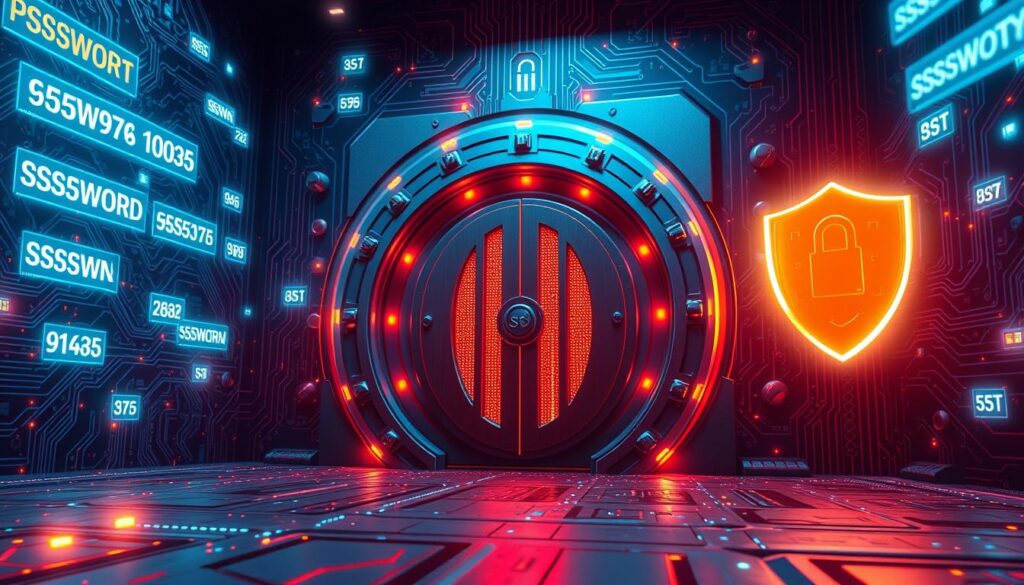In today’s world, our digital lives are more important than ever. Cybersecurity is key for keeping our online presence safe. A recent study found that 81% of data breaches happen because of weak passwords. People often use the same password for 3 to 4 accounts, making it a big problem.
Cyber threats like identity theft and financial fraud can be very harmful. The average cost of a data breach is $4.35 million. Also, 55% of people don’t know about their digital footprint. And 40% of companies say they don’t have enough cybersecurity awareness among their employees.
It’s important to keep your software up to date. This can lower the risk of cyberattacks by up to 85%. Regular updates are a big part of keeping your data safe.
Cybersecurity isn’t just for individuals; it’s also crucial for businesses. A cyber attack can shut down a small business in just six months. But, companies that focus on cybersecurity can see a 60% drop in attacks.
With more people working from home, cybersecurity funding for small businesses has gone up by 20%. This shows how important it is to keep your online presence safe.
Key Takeaways
- Cybersecurity is crucial for online security and data protection in today’s hyper-connected world.
- Strong passwords and two-factor authentication are essential for preventing data breaches and cyber threats.
- Regular software updates can reduce the risk of cyberattacks by up to 85%.
- Businesses that prioritize cybersecurity see a 60% reduction in incidents compared to those that do not.
- Cybersecurity awareness among employees is a major risk factor for companies, with 40% citing it as a concern.
- Implementing cybersecurity measures can help prevent severe consequences such as identity theft, financial loss, and reputational damage.
Understanding Modern Cybersecurity Threats
Cyber threats are getting more complex, posing big risks to people and companies. The need for strong network security has grown. Reports show cyber threats have jumped by 50% in a year, with ransomware leading the way.
Common cyber attacks include phishing, malware, and ransomware. These can cause huge financial losses, damage reputations, and expose personal data. Almost 90% of data breaches happen because of human mistakes, showing how crucial awareness is.
To fight these threats, using network security tools like firewalls and antivirus is key. It’s also vital for everyone to focus on internet safety. This means using strong passwords, being careful with links and downloads, and keeping software up to date.
Some important stats on cyber threats include:
- 43% of cyber attacks target small businesses
- 1 in 3 U.S. companies have experienced a data breach in the past year
- The average cost of a data breach is approximately $4.24 million
The Foundations of Digital Security
Building a solid base in digital security is key to keeping information security and digital privacy safe. It’s important to stop unauthorized access to sensitive data. A strong password is a must, being unique and complex to avoid easy guessing or cracking.
Keeping software up-to-date is also vital for digital privacy and information security. Updates often fix new vulnerabilities that attackers could use. By always using the latest software, you lower your risk of being hacked.
Two-factor authentication (2FA) is another important part of digital security. It adds an extra step to log in, making it harder for hackers to get in. This can be through SMS codes, biometric scans, or authenticator apps.
Here are some top tips for strong digital security:
- Use a good password manager for unique, complex passwords
- Turn on 2FA whenever you can
- Keep software and operating systems updated
- Be careful with links and downloads from unknown sources
By following these tips and keeping up with the latest information security and digital privacy advice, you can greatly lower your risk of cyber attacks.
Essential Password Management Strategies
Effective password management is key for online security and data protection. Most people handle about 100 passwords. It’s hard to make and remember strong, unique passwords for each account. Weak or stolen passwords can lead to big problems like data breaches and identity theft.
To lower these risks, it’s smart to use strong passwords, password managers, and multi-factor authentication. These steps help protect sensitive information and reduce breach chances.

- 81% of data breaches are caused by weak or stolen passwords.
- 63% of people reuse the same password across multiple accounts.
- Multi-factor authentication can block up to 99.9% of automated attacks.
By using strong password management, people and businesses can keep their online presence safe. This protects their online security and data protection.
Securing Your Network Environment
Network security is key to keeping your data and devices safe from hackers. To protect your network, make sure your router is set up right. Also, use a virtual private network (VPN) when you’re on public Wi-Fi.
A good router blocks cyber attackers from getting into your network. A VPN encrypts your online activity, making it hard for hackers to get your data. It also keeps your identity and location safe while you’re online.
- About 90% of small office/home office (SOHO) routers lack antivirus or integrity tools, making them easy targets for hackers.
- Most network devices come with default settings that are rarely changed. Studies show over 80% of organizations don’t update these settings, leaving big security holes.
- Setting up network segmentation can cut down attack impact by up to 50%. It limits what intruders can do and how far they can go.
By following these steps, you can make your internet safer and keep your data safe from cyber threats.
Data Protection and Encryption Methods
In today’s digital world, data protection is key. With more cyber threats, keeping personal and business info safe is vital. In 2023, over 353 million people were hit by data breaches. Identity theft cases also hit 1.1 million.
To fight these issues, encryption is a must. It keeps data safe when it’s moving or stored.
Some top encryption methods are:
- Advanced Encryption Standard (AES)
- Triple Data Encryption Standard (TDES)
- Rivest Shamir Adleman (RSA) algorithm
- Blowfish encryption
- Twofish
- Format-Preserving Encryption (FPE)
- Elliptic Curve Cryptography (ECC)
Watching for data decryption attempts is crucial. It helps spot and stop threats early. Industries like healthcare and finance need strong encryption to keep data safe.
Not following data privacy laws can lead to big fines and harm to reputation. So, making data protection and encryption a top priority is vital. It keeps sensitive info secure and prevents big financial losses.
Social Engineering Defense Tactics
To fight cyber threats, it’s key to know about social engineering defense tactics. These include spotting phishing, being careful on social media, and training employees. By doing these, people and companies can lower the chance of falling to social engineering attacks. These attacks are a big way hackers get into systems.
Some numbers show why we need these tactics. For example, 90% of data breaches happen because of people. Also, 1 in 5 workers fall for phishing. And, cybercrime costs are expected to hit $10.5 trillion by 2025. To fight back, using multifactor authentication can cut account compromise risk by up to 99.9%.

- Regular security awareness training to educate employees on recognizing phishing attempts and other social engineering tactics
- Implementing multifactor authentication to add an extra layer of security to accounts
- Practicing safe social media habits, such as being cautious when clicking on links or providing personal information online
By focusing on social engineering defense and internet safety, we can shield ourselves from cyber threats. This way, we can avoid falling prey to social engineering attacks.
Mobile Device Security Best Practices
More people use mobile devices for work and personal stuff. About 85% of companies have faced a mobile security issue in the last year, a Verizon survey found. This shows how vital it is to have strong mobile security plans to fight cyber threats and keep our digital lives safe.
To keep mobile devices secure, we need to manage app permissions, encrypt our devices, and have remote wiping options. These actions can greatly lower the chance of data leaks and keep our private info safe. Also, using mobile security software and device management tools helps stick to security rules and block unauthorized access to our devices.
Key Mobile Security Measures
- Implementing data encryption to safeguard personal information
- Enabling remote wiping capabilities to prevent data breaches in case of lost or stolen devices
- Using mobile device management solutions to enforce security policies and manage devices
- Regularly updating mobile device software and applications to prevent known security vulnerabilities
By following these best practices, we can protect our digital privacy and stop cyber threats. It’s important to keep up with the latest mobile security dangers and act early to avoid them. This way, we can keep our mobile devices and the data they hold safe and secure.
Regular Security Maintenance Protocol
Keeping your cybersecurity strong is key. This means taking steps to stop, find, and fix cyber threats. Online security is very important. Regular checks help keep your systems and data safe from hackers.
Important parts of security maintenance are updates, patches, and checks for weak spots. These steps help find and fix security issues. For example, cybersecurity experts say checking access controls can cut down on unauthorized access by 40%.
Using more than one way to log in can also help a lot. Studies show it can cut down unauthorized access by up to 99.9%. Regular checks for weak spots can find over 80% of potential issues before they happen.
Other key parts are network segmentation, planning for incidents, and training employees on cybersecurity. By focusing on these, you can lower the risk of cyber attacks a lot. Regular security checks are vital for strong online security and fighting off new cyber threats.
Conclusion: Building a Robust Security Culture
Building a strong cybersecurity culture is key in today’s digital world. Organizations face many threats and need a security-aware team. Training employees regularly helps lower the chance of security mistakes.
A culture where everyone protects digital assets is vital. It helps spot and report security risks early. By making security part of daily work and rewarding good behavior, teams work better together to protect online data.
Creating a cybersecurity culture that values digital privacy is more than following rules. It’s a way to gain trust from clients and partners. With leadership support, constant training, and regular security checks, companies can stay safe from new cybersecurity threats.

